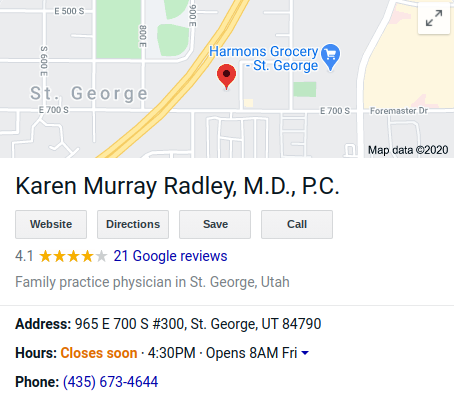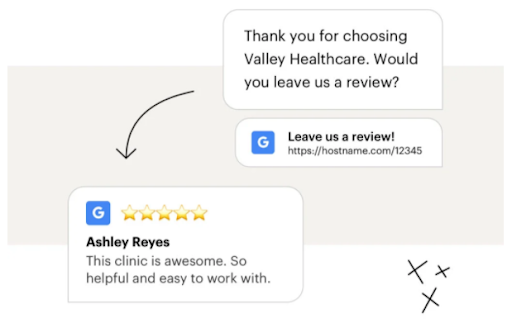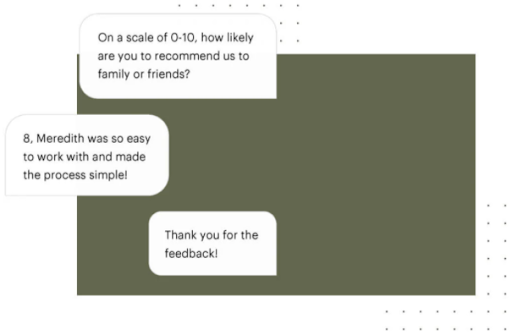With a host of digital tools and marketing metrics at your fingertips, it can be hard to know which ones matter the most. Tracking the following nine marketing metrics will help you stay on target for the budget and patient acquisition goals of your healthcare system.
1. Number of reviews on Google
Definition: The number of Google reviews on your Google Business Profile listing. (In the case of our example, the number is 21.)

Why it matters: Google is the number one search engine patients take to when looking for a new healthcare provider. And 90% are there to read the patient reviews. Wondering how to boost your ranking on Google and appear in more searches? One of the answers is to increase the number of reviews on your Google Business Profile listing.
The average number of Google reviews for a local business is 39. But the average number of Google reviews for the top 3 local positions is 47.
How you can improve it: If your number of reviews is lacking, you can automate a post-care text asking patients to review your practice on Google.

2. Average patient rating
Definition: Your average rating from patients on Google reviews. (In this example, the average rating is 4.1.) Although ratings from other sites may be listed in search engine results, your average Google rating is the first to appear in your Google Business Profile listing.


Why it matters: In the case of online reviews, quantity isn’t everything. Keeping track of the quality and the average rating is a crucial part of the feedback process. Are patients actually happy with the care you provide? Are there common themes in the feedback relating to billing, service, convenience, etc.? After taking an inventory, what are you doing to address this feedback?
While it’s normal to have some variation, it’s important to keep an eye on this average, as it is what so many future patients use to evaluate your practice before converting.
Overall, local businesses have an average of 4.42 stars on Google Business Profile. However, 73% say written reviews make more of an impression on them than star/number ratings. So while the average is important, the quality of reviews can be more important.
How you can improve it: Ask patients via text message to leave a review of your practice on Google. 76% of patients asked to leave a review will. And 73% of those written will be positive.

3. Patient satisfaction scores
Definition: An internal metric taken from a patient satisfaction survey or feedback request. While public, online reviews are an important part of patient acquisition, it’s also good to track patient satisfaction with metrics from your own healthcare organization. This way, you can ask for specific feedback that patients may not include on a review site or that may vary from visit to visit.
Why it matters: Not only will this provide helpful information for you, but it also sends a clear message to patients that you want to provide the best care for them.
How you can improve it: Send a post-appointment text message asking for feedback. Response rates for texts are almost 40% higher than response rates for emails.

4. Patient acquisition cost
Definition: The total average cost spent to acquire a new patient, including all spend for ads and other marketing tactics, salaries, and overhead.
How to calculate it: Take the total spend for acquiring new patients (marketing spend (including ad spend), salaries (including commissions and bonuses), overhead, etc.) in a given time period and divide it by the number of new patients acquired in that time.
Example: A healthcare system spends $100,000 in ads and other marketing programs in Q1. Add in $200,000 for salaries and another $50,000 for overhead, divide by the number of new patients in Q1, and your equation should look like this:
$850,000 / 40 = $8,750 per patient
Why it matters: This number tells you how effective your patient acquisition strategies are related to the cost, and provides a general overview of the marketing budget. If you notice your patient acquisition costs increasing with new digital marketing techniques, it’s time to revisit tactics and channels to ensure your patient acquisition cost isn’t too high.
How you can improve it: The spend for ad campaigns and other patient acquisition methods can really add up. But do you know what is low-cost and has a 98% open rate? Text messaging. Consider adding a textable number to the patient journey. This is a low-cost way to let potential patients come to you when they’re most likely to convert and on the channels they prefer.
Another effective patient acquisition tool is webchat. Since patients do their research online anyway, a web chat platform is a good way to meet them there and provide personalized help.
Modern patients require modern acquisition strategies. Reach your patients with effective and low-cost methods like texting and webchat—answer common questions, resolve concerns, and win the trust of potential patients.

5. Speed to payment (or days in accounts receivable)
Definition: The average time it takes to collect payments from patients/average
number of days it takes to collect payment on a bill.
How to calculate it: To measure the number of days it takes to collect on healthcare bills for your practice, you need to understand the daily average for charges, the number of days in the amount of time you’re measuring, and your total accounts receivable.
Add up all of the charges/bills sent in the last six months (if this is the time period you’re measuring) and divide that number by the total number of days in the last six months (again, if this is the time period you’re measuring). This equals your average daily charges.
Next, divide the total accounts receivable by the average daily charges. This number is your days in accounts receivable or your speed to payment number (how long it takes to get paid).
Example:
A healthcare clinic sent out $250,000 in invoices and bills in the last 3 months (or 91 days). Total accounts receivable sits at $50,000.
$250,000 / 91 = $2,747.25 (average daily charges)
$50,000 / $2,747.25 = 18 (days in accounts receivable, or the number of days on average it takes to collect your payments)
Why it matters: Convenience matters to patients today. And speed to payment is an area that can be transformed in a major way. 87% of health systems still leverage paper and manual processes for collecting medical bills. It can take weeks and weeks for a patient to respond to snail mail, and there’s the possibility of personal information being lost or stolen during this process.
80% of patients prefer to pay their provider from their mobile phones. But only 15% of healthcare practices are delivering with mobile payment options. The longer and more complex your payment process is, the less patients will be satisfied with their overall experience.
How you can improve it: Offer mobile payments via text. It’s secure, it’s speedy, and it’s what patients prefer. Mobile payments increase the speed to payment and the convenience factor that so many patients today expect.

6. Marketing influenced patient %
Definition: The percentage of new patients who interacted with marketing at any point in their journey to conversion.
How to calculate it: For a given time frame, take the total number of new patients who were influenced by marketing (commercials, banner ads, social media campaigns, etc.) and divide it by the total number of new patients. (You can track the number of patients influenced by marketing by collecting information in customer feedback surveys throughout their journey with your clinic or facility.)
Example: A healthcare system acquired 5,000 new patients in Q1. 3,000 of those patients interacted with marketing before converting.
3,000 / 5,000 = 60% of new patients influenced by marketing in Q1
Why it matters: New patients can come from a variety and combination of sources. This metric helps you know how influential your marketing is throughout the patient journey and where you can focus your efforts—be it generating new leads with pay-per-click ads, nurturing leads through social media, or closing deals with Google Business Profile.
Perhaps a new patient hears about a healthcare practice from a friend, sees a few banner ads with positive reviews, and then converts. Although the patient didn’t originate from the healthcare company’s marketing efforts, they were influenced by them. Not every patient will start as a marketing lead, but with this metric, you can discover exactly how many were influenced, and see which efforts are worth the cost.
7. Marketing originated patient %
Definition: The percentage of new patients who originated directly from marketing efforts such as direct mail, pay-per-click ads, or other forms of marketing.
How to calculate it: Divide the total number of patients who originated as marketing leads by the total number of new patients for a given time period.
Example: A health clinic acquired a total of 55,000 new patients in a year. 5,000 of those patients heard about the clinic from Spotify ads; 15,000 followed a link from a YouTube campaign; 10,000 originated and converted from other marketing efforts in that year.
30,000 / 55,000 = 55% marketing originated patients in that year
Why it matters: This percentage is a great indicator to know if your marketing efforts are helping patients through the conversion funnel—from awareness and consideration to conversion. If this percentage is low, you’ll want to evaluate the sources of your new patients, and adjust your tactics accordingly.
8. Marketing % of patient acquisitions cost
Definition: The marketing portion of your total patient acquisition cost.
How to calculate it: Take the total marketing cost (expenses, salaries, commissions, bonuses, and overhead for the marketing department only) and divide it by the marketing and sales costs (program and advertising spend, salaries, commissions, bonuses, and overhead) used to calculate the total patient acquisition cost for a given time frame.
Example:
Total marketing cost: $200,000
Sales and marketing cost: $400,000
$200,000 / $400,000 = 50% Marketing % of Patient Acquisition Cost
Why this matters: This measures the impact marketing has in acquiring new patients and gives leadership a good sense of successes and opportunities for growth. An increase in marketing % of PAC could indicate beginning stages of your healthcare business where you’re spending more to acquire more. Or if you’re already a well established business, it could mean your marketing team is underperforming and not getting bonuses or overspending.
9. Net Promoter Score (NPS)
Definition: A metric used to predict business growth based on customer experience.
How to calculate it: Start by asking patients on a scale of 1 – 10 how likely they are to recommend your healthcare practice to a friend or colleague.
From there, group patients into three categories:
- Promoters: score 9 – 10 and are likely to be loyal patients and actively recruit others to your business.
- Passives: score 7 – 8 and can be persuaded one way or another toward your business or toward a competitor.
- Detractors: score 0 – 6. These patients didn’t just dislike their personal experience with your healthcare business, they’re sure to dissuade others from using your services.
Next, calculate the percentage of Promoters and Detractors from your total responses. Subtract the percentage of Promoters from the percentage of the Detractors, and that will give you your Net Promoter Score (NPS).
Example: A health clinic had 100 patients respond to their survey. 60 patients rated 9 – 10, 25 patients rated 7 – 8, and 15 patients rated 0 – 6.
Promoter percentage = 60%
Detractor percentage = 15%
60% – 15% = 45 NPS
Why this matters: Both ends of the spectrum are going to spread word about their experience. Both types of reviews can be responded to in helpful ways to help your practice grow.
How you can improve it: You can improve your NPS by improving your patient experience. By offering conveniences like texting to schedule appointments, mobile bill payment, web chat for FAQs, and other personalized and customized touch points along the patient journey, your scores will improve. Happier patients make for more positive reviews and Net Promoter Scores.
Fortunately, you don’t have to track these metrics on your own. Podium can help you through every step of the patient acquisition process. Manage your leads, generate reviews, and stay on top of payments from one powerful inbox. To get started, request a quote today.



